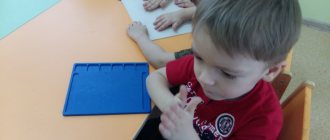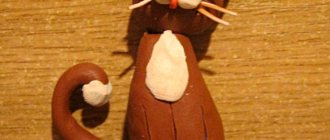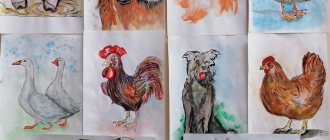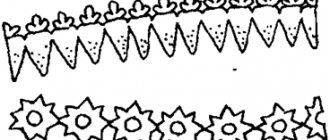On the topic: methodological developments, presentations and notes
Summary of educational activities with children in the cognitive-speech direction in the senior group. Theme: "Spring".
Summary of educational activities with children in the cognitive-speech direction in the senior group. Theme: "Spring". Tasks:1. Expand both.
Summary of educational activities to familiarize yourself with the outside world for children of the older group with special needs development. Topic: “Conversation about winter.”
The summary contains tasks, games, exercises aimed at developing and consolidating knowledge on the topic “Winter”.
Summary of educational activities on the development of elementary mathematical concepts for children of the senior group on the topic: “The History of Clocks”
Summary of integrated educational activities for the development of elementary mathematical concepts in a group of general developmental orientation for children from 5 to 6 years old No. 1 Topic of the lesson: History.
Summary of continuous educational activities on decorative drawing on the topic “Fairytale Gzhel” (Senior group)
Summary of continuous educational activities on decorative drawing on the theme “Fairytale Gzhel” (Senior group).
Summary of educational activities on cognitive development on the topic “Energy Saving” in the senior group.
-introduce children to saving electricity; -develop children's attention to the problems of using electricity; - to form motivation for saving resources and energy; - to develop children’s speech.
Summary of educational activities on speech development on the topic for children of the senior group using computer technology. "Journey to the Land of Fairy Tales"
Summary of educational activities on speech development on the topic for children of the older group using computer technology. “Journey to the land of fairy tales.”
Preview:
State budgetary educational institution
Secondary school No. 569
Nevsky district of St. Petersburg
Structural unit "Department of preschool education of children
Summary of GCD on modeling on the topic “Household Appliances” Iron
Educator: Stefeikina T.E.
Goal: learn to depict the figure of an iron in modeling, correctly conveying the relationship of parts. Strengthen sculpting techniques: pinching, smoothing.
Educator: Hello, guys! Today we will have an unusual lesson about ordinary things. Guess what we'll be talking about:
How to cope with all the work?
Electrical appliances are our assistants. Without them it would be difficult for us to manage our affairs.
Guys, where can you use electrical appliances?
Children: at home, on the street, at work, at a factory, in a hospital, etc.
Educator: Absolutely right. Now we will play the game “What electrical appliance?”
Preview:
Summary of educational activities
sculpting using non-traditional techniques
on the topic “Household Appliances” (senior group)
Goal: Expanding and deepening understanding of household appliances, their parts and purpose.
NGO "Cognitive Development"
- Enrich children's understanding of the surrounding objective world
- To strengthen children's understanding of objects that make human work easier
NGO “Social and communicative development”
- Fostering friendly relationships among children and a desire to help others
- Instill in children a respectful attitude towards work
- To develop in children the ability to evaluate their own actions and the actions of their peers
- Clarify, expand and activate children’s vocabulary on the topic “Household Appliances”
- Strengthen children's ability to describe a particular household appliance
- Strengthen children's ability to use simple and complex sentences in speech
NGO "Artistic and Aesthetic Development"
- Strengthen children's ability to independently choose colors
- Develop children's color perception of the world around them
- Improve the development of fine motor skills of the arms and hands in children
- Learn to evoke a positive response to an image
- Continue to strengthen in children the ability to use various methods of connecting parts when sculpting
- Preserving and strengthening children's health
- Preventing fatigue in children
- Looking at illustrations of household appliances
- Didactic games: “The fourth odd one”, “Guess the description”, “Cut pictures”
- Conversation: “Our smart assistants”
- Introduction to household appliances in everyday life
- Toys on the theme “Household Appliances”
- Illustrations of household items (iron, refrigerator, stove, vacuum cleaner, etc.)
- Sets of plasticine, cardboard with a picture of a vacuum cleaner, stacks, boards, hand wipes
Educator: Hello, guys! Today we will have an unusual lesson about ordinary things. Guess what we'll be talking about:
How to cope with all the work?
Abstract of GCD for senior and preparatory groups. Electrical appliances
"Electrical appliances." GCD on cognitive and speech development for kindergarten
GCD for children of senior and preparatory preschool age “In search of Nolik”
Description of work: I offer material that I hope will be interesting for teachers and educators working with children of senior and preparatory age for school (5-7 years old). Children go on an exciting journey – a search in order to find Nolik (the hero of the cartoon “The Fixies”), who hid in the group’s wall clock. Goal: To update children’s knowledge on the topic “Electrical Appliances” Objectives: - correctional and educational: learn to form the diminutive form of nouns, - correctional and developmental: develop cognitive interest; develop children's logical thinking by solving riddles, develop dialogical speech, develop auditory attention and memory; — correctional and educational: to cultivate a culture of dialogue; the ability to listen carefully to your interlocutor Equipment: subject pictures on the topic, envelopes with tasks from the Fixies, a ball, an audio recording of physical exercises, pictures depicting the cartoon characters “The Fixies”, green, yellow and red palms
. GCD move:
Children stand in a semicircle
Educator: We have known these words since childhood. Very wise words When meeting, say hello - Good morning! - Good morning, my good friend! -Good morning to all the people around! -Good morning to the sky and birds! - Good morning to smiling faces! I really want everyone to have a good morning, good afternoon and good evening today! Especially for our children, because they came to kindergarten to play, communicate and learn a lot of new and interesting things. Now hold hands and create a chain of friendship. Children holding hands say the words: We are the friendliest children and there is no friendlier group in the world! Educator: Now, guys, sit down at the tables. Guys, do you know that our fingers can talk? Educator: I’ll teach you now! They will tell us the topic of our lesson. FINGER GYMNASTICS What's that noise in this kitchen? bending the little fingers We will fry cutlets. bending the ring fingers
We will take the meat grinder,
rotating the middle fingers around each other.
We will quickly turn the meat.
rotation of the index fingers around each other
Using a mixer, beat together
rotation of the thumbs
All we need for the cake is
the connection of the
To bake the cake as quickly as possible,
the connection of the ring fingers
We turn on the electric oven.
connecting middle fingers
Electrical appliances are a miracle!
movement of the index fingers.
It would be bad for us to live without them.
Shrug
(Taken from the Internet)
Educator: did you guess the topic of our lesson? That's right ELECTRICAL APPLIANCES They are our faithful helpers. These are complex devices that are powered by electricity and perform a wide variety of household tasks. Some wash clothes, others help in the kitchen, others collect dust, others store food, etc. Electrical appliances save our time and energy. Imagine if all electrical appliances suddenly disappeared from your home. How much more difficult it would have been for people then! Educator: Guys, listen to the music and guess what cartoon it is from? Can you name its main characters? (Simka Nolik Papus Masya Dedus DimDimych Nipper Bug Fire Igrek Spool Verta Professor Chudakov) Do you want to play with fixies? And here they are! (a picture of fixies is displayed) Who are fixies? These are fictional characters who live in electrical appliances, care for them, repair them, and therefore extend the life of the appliances, and fixies, in turn, feed on energy from these appliances. Fixies help devices, and devices help fixists. Do you want to play with them? (Yes!) Our task will be to find the smallest fixie - Nolik. He hid somewhere in the group, and his family came up with tasks for you and sent them by registered mail!
Educator: In order to find Nolik we will need to put together a puzzle. On the other side it will be written where he hid.
The first task of the fixy family: we need to guess all the riddles about electrical appliances. Making riddles. Attaching subject pictures to the board. Puzzles. Guess quickly, my friend, What kind of snowy tower is this? Saves milk, sour cream, kvass for us in the heat. (Refrigerator) In the linen country A steamboat floats along the Sheet River, back and forth. And behind him there is such a smooth surface - Not a wrinkle can be seen. (Iron) Walks and wanders along the carpets, leading his nose to the corners. Where he passed, there was no dust, Dust and rubbish were his lunch. (Vacuum cleaner) What kind of miracle, what kind of box? He himself is a singer and himself a storyteller, and at the same time he demonstrates films. (TV) Only me, only me, I’m in charge in the kitchen Without me, no matter how hard you work, you’ll be satiated without lunch... (Electric stove) There are round buttons on the sides of the box. Right there in the corner there is a handle with a tube on a cord. (Electric kettle) A voice is heard through the field and forest. He runs along the wires - you can say it here, but you can hear it there. (Phone) If you press the button, music will sound / music center / Look at my side, a top is spinning inside me. He doesn’t hit anyone, but he will knock down everything! (Mixer) (taken from the Internet) The child who guessed the answer pins object pictures on the board. The first part of the puzzle is fixed on the board
Educator: The Fixies have prepared questions for us. By answering them, we can get another piece of the puzzle. — What is each electrical appliance needed for? (Survey of each child) - What electrical appliances are in the kitchen, bedroom, living room? — What powers electrical appliances? —Where does electricity live in each house? — Why can’t you touch the sockets? — What rule do you need to know and be sure to follow when you leave home? Children answer in two or three sentences. For example: There is a refrigerator in the kitchen. Food is stored in it for a long time and does not spoil. Connecting another piece of the puzzle Educator: Guys, here is the next envelope with the assignment. Call electrical appliances affectionately. I throw the ball, name the electrical appliance, and you say affectionately: Iron - iron, telephone - telephone, tape recorder - tape recorder, teapot - teapot, refrigerator - refrigerator, vacuum cleaner - vacuum cleaner, socket - socket We continue: Repeat and complete my sentence: Grandfather gets it in the kitchen milk from (refrigerator) Mom washes clothes in (washing machine) Julia watches the program “Good night kids” on (TV) Grandma cooks cabbage soup on (Electric stove) Dad cleans the carpet (with a vacuum cleaner) Mom whips cream (with a mixer) Mom dries wet hair (PHENOM ) Let's connect the next puzzle Educator: Well done, guys, let's open the next letter. The teacher takes out sheets from the envelope; they show: “NOISE” APPLIANCES. The sheet of paper shows the outlines of electrical appliances that are hidden behind each other.
Children need to find them, name them and tell how they are used. The sentence should be (for example) I have an electric lamp. I turn it on when I sit down to draw, I have a sewing machine at home, my mother loves to sew, I have a washing machine, my mother and I wash clothes together. As a family, we love watching TV in the evenings. On weekends, my dad and I like to vacuum the carpets. When the laundry is dry, mom irons it and I fold it. When guests arrive, we boil water in an electric kettle and drink tea with the whole family. Physical exercise And now I will ask, children, to leave the tables and rest a little. Let's do Nolik's favorite gymnastics. (The music center is turned on with a recording of a charging song)
DRYTS-TYTS TV, TV, TV, TV, Te-te-te-te-TV. Knock-knock TV, Knock-knock TV, Knock-knock TV And two fixies inside. Knock-knock TV, Knock-knock TV, Knock-knock TV And two fixies inside Educator : Well done, guys, we had a rest and we continue And in the next letter, the fixies offer us to place electrical appliances in the apartment (each child is given a picture with an electrical appliance on magnets, on the board there is a diagram of the apartment: living room, kitchen, bathroom) The guys are completing the bath, kitchen, living room) When the children attach the appliances to the board, they explain why it is convenient for the appliances to be in a particular room. Well done! Let's put the puzzle together! Educator: Guys, listen to the poem carefully. We have helpers who don’t abandon us in difficult times. If mom is all busy, we get to work. Here at the request “Help!” We iron dresses, iron trousers, our hands can do everything. The vacuum cleaner makes loud noise. Our carpet shines like snow. We didn’t forget about the laundry, we washed it and went through it. And then we rinsed, Our hands did not get tired. We dried our things, our clothes sparkle with cleanliness. We sat down for a minute and watched TV. We hear the phone ringing, someone is in a hurry to visit us. We'll put the kettle on the stove and give tea to all the guests. Our house is full of music, We dance and sing in it. We will learn how to behave in everyday life in the garden. (taken from the Internet) Tell me, what electrical appliances were discussed in the poem? (iron, vacuum cleaner, washing machine, TV, telephone, kettle, tape recorder) Educator: Guys, we have put together a puzzle. Let's turn it over and see where Nolik was hiding? On the back it says that the zero is hidden in the clock. The teacher removes the clock from the wall and pulls out a toy zero. You did a great job with all the fixers' tasks! Thanks a lot! Guys, let's remember what we talked about in class today? (Children's answers) What did you like most about the lesson? (Children's answers) Teacher: You know that fixies have this sign - a handle - a rostrum. Palm with three fingers spread. Sometimes it's a gesture of greeting, but more often it's a sign of a job well done. I invite you each to evaluate your work. Place your palm on the board. To green if you think you did a great job today, to yellow if you didn’t do very well and will try harder in the future, and to red if you are completely unhappy with your answers. Children strengthen their palms. Educator: Of course, the children actively answered questions and completed difficult tasks with interest, so we have green palms on the honor board!
We recommend watching:
Summary of GCD for introducing older preschoolers to the work of the poet Fet Summary of plot-based GCD in physical education for children of the senior group Summary of GCD in the senior group of compensatory orientation GCD in kindergarten for older preschoolers
Similar articles:
Summary of GCD in the senior group on the topic “Communication”
Summary of GCD in the senior group of kindergarten on the topic “Relaxation”
Summary of a lesson on cognition in the senior group on the topic “Dairy products”
Summary of a lesson on cognition in the senior group on the topic “Construction professions”
Abstract of educational activities for cognition in the senior group of kindergarten on the topic “Russian folk crafts”





